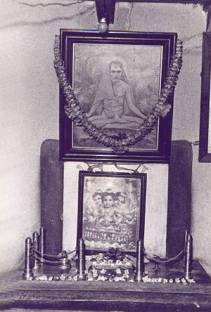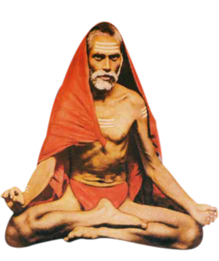A compact Biography of Shri Vasudevanand Saraswati Tembe Swami Maharaj
The Beginnings: BackgroundNineteenth Century Indian society epitomized cultural confusion. The Vedic religious traditions that withstood a millennium of Islamic tyranny were shaking at their very foundations by the systematic intellectual onslaught of the British rulers. The people were loosing their faith in the traditions, having forgotten the essentials of their own religion. The doctrines of Vedic religion appeared ambiguous and contradictory, the practices so diverse as to be conflicting and mythology bereft of any meaning. There was a dire need for a person who could not only make the people clearly understand these doctrines but also demonstrated, in the form of his own dedicated life, the ideal practice of religion and finally guided them on to the divine path. Such a person indeed was Shri Vasudevanand Saraswati (Tembe) Swami, the great saint and ascetic who revived the ancient Dattatreya tradition and embodied in his short life the ideals of Brahmacharyashram, Grihasthashram and Sanyasashram. |

| He was born in the village of Managaon near Savantwadi, then a princely state in southern Maharashtra, in a traditional, religious Brahmin family, devoted to Lord Dattatreya. His grandfather Haribhataji used to recite Shri Gurucharitra regularly. He also used to make manuscripts of the holy book to supplement his meager income. His father Shri Ganesh Bhataji Tembe was a devotee of Dattatreya, spending long periods, sometimes years together, in the remote Ganagapur temple of the Lord in Karnataka. His mother Ramabai also used to spend her time in religious pursuits like jap (recitation of mantras), pradakshina, path(reading holy books), atithisatkar (hospitality) etc. After a particularly long stay in Ganagapur, Lord Dattatreya appeared in a dream and instructed Shri Ganesh Bhataji to return to Managaon and attend to the duties of a householder (grihastha), promising to incarnate as their son. It was after his return from Ganagapur that his eldest son Vasudeo was born on the 5th day of the dark fortnight of the month of Shravana of A.D.1854. Tembe family was endowed with spiritual riches (daivi sampat) but had little temporal wealth. Their priestly duties were not adequate for the livelihood and Vasudeo’s grandfather took to agriculture as a side business. |
Elementary EducationAt the age of three years Vasudeo started attending the private school held in the Yakshini temple in the village. He had to learn writing with his fingers on a layer of dust, a very tiring and painful practice. Apart from the secular education in the school, Vasudeo also received traditional oral education from his grandpa Hari Bhataji. With his sharp intellect and quick memory Vasudeo soon mastered the basics of Sanskrit grammar and poetry. |
BrahmacharyashramAs per the tradition, Haribhataji performed the Maunjibandhan of his beloved grandson Vasudeo, at about the age of 8 years. This consists of initiation to the Gayatri Mantra and thus to the first of the four Ashramas, Brahmacharyashram, literally meaning the phase of celibacy. This period in a Brahmin’s life stage devoted to the Vedic studies. The and Immediately after this, the young Vasudeo started the daily rituals ordained by the scriptures viz. Sandhya twice a day, 1000 recitations of Gayatri mantra, daily reading of Shri Gurucharitra - the bible of Shri Datta tradition etc. He also completed 2.4 million recitations of Gayatri. He strictly followed the religious disciplines prescribed by scriptures, specifically the Gurucharitra. He then commenced his studies of Vedas, the holiest of the Hindu scriptures, under the guidance of Shri Tatya Bhataji Ukidave. He woke up daily before sunrise and took his bath and insulated himself from all impurities and contamination during the religious practices. He only took fresh pure (sattvik) and vegetarian food prepared by himself or by his mother and never ate outside his home. The food thus prepared, he used to offer to sacrificial fire (Vaishvadev), the cow (Gograas), to the crow (Kaakbali) and finally to the Lord Datta, before partaking it in the manner ordained by scriptures. During the meal any impurity in the environment led him to leave his food and fast for the day. He used to observe the fasts on the 11th days (Ekadashi) of each fortnight, without even drinking water and abjuring sleep during day or night. Vasudeo, with his sincerity, sharp intellect and phenomenal memory, soon completed his study of the Vedas and became proficient in the priestly duties. As a result he became a respected and beloved figure in the Managaon and neighboring villages and started contributing to the family livelihood. During this period, he also studied some astrology and Sanskrit poetry with one Shri Sadhale Shastriji. However his perfection in astrological calculations soon started embarrassing Sadhale Shastriji by being more accurate than the latter’s. This led Sadhale to stop Vasudeo’s tuition. |
MantrasiddhiVasudeo’s austerities, dedicated practices and devotion soon led to his acquiring Mantrasiddhi i.e., supernatural powers manifested through Vedic mantras. There are numerous examples of these. Once he was traveling by foot with a fellow priest, to a nearby village through a forest. Suddenly they saw a snake slithering ahead of their path. His companion asked Vasudeo whether he could try a mantra on it. Quickly, Vasudeo holding some dust nearby in his hand and invoking an appropriate mantra, sprinkled it in a circle around the passing snake. Suddenly, the snake was stopped in his tracks. It could not cross the circle and started moving round and round within it. The two priests went about their way. Having finished their business in the neighboring village, they returned to Managaon, forgetting all about the snake. Only the next afternoon, Vasudeo suddenly remembered the snake and went to the spot along with his friend. To his horror, the snake was lying listless in that circle apparently totally exhausted after unsuccessfully trying to break through the circle. Quickly, Vasudeo took some more dust and reciting a remedial mantra, sprinkled it over the poor creature. The snake, as if suddenly released from the bondage, sprang away into the bushes. This so deeply affected Vasudeo - we better now address him Vasudeo Shastriji, or simply Shastriji, that he never again used any restraining mantras on living creatures. Once at his sister’s place, Vasudeo displayed his mantric prowess by turning her intractable cow docile. He also helped local police by providing an accurate description and modus operandi of a particularly evasive gang of robbers. Another time, he correctly predicted the capture of the accused by the police of another state. He also helped people in distress by relieving them of their chronic ailments. This augmented his reputation in Managaon and the surrounding area. He was now respectfully addressed as Shri Vasudeo Shastriji. However, it must be emphasized here that Shri Vasudeo Shastriji never employed his powers for either monetary gain or to impress others in any way. He only used his powers to help the needy and to relieve suffering. We shall see that this compassion for his fellow beings continued to be a major motivation in his entire life. |
Download PDF version of compact bography

